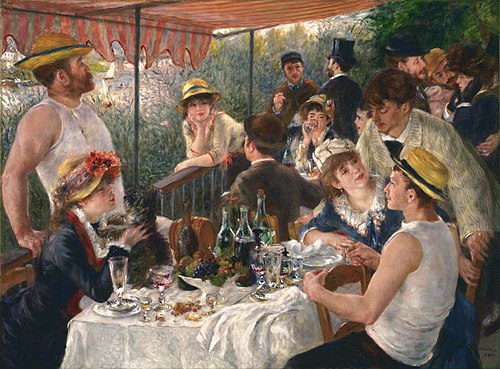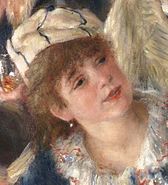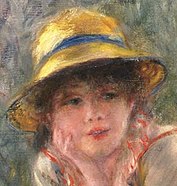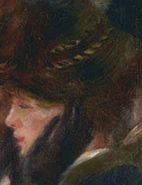
In photography, filmmaking and video production, a wide shot is a shot that typically shows the entire object or human figure and is usually intended to place it in some relation to its surroundings. These are typically shot now using wide-angle lenses. However, due to sheer distance, establishing shots and extremely wide shots can use almost any camera type.

In a movie a medium shot, mid shot (MS), or waist shot is a camera angle shot from a medium distance.
The film industry is built upon many technologies and techniques, drawing upon photography, stagecraft, music, and many other disciplines. Following is an index of specific terminology applicable thereto.

In photography, shutter speed or exposure time is the length of time that the film or digital sensor inside the camera is exposed to light when taking a photograph. The amount of light that reaches the film or image sensor is proportional to the exposure time. 1⁄500 of a second will let half as much light in as 1⁄250.
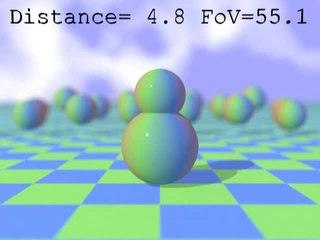
A dolly zoom is an in-camera effect that appears to undermine normal visual perception.

In photography and cinematography, a wide-angle lens is a lens covering a large angle of view. Conversely, its focal length is substantially smaller than that of a normal lens for a given film plane. This type of lens allows more of the scene to be included in the photograph, which is useful in architectural, interior, and landscape photography where the photographer may not be able to move farther from the scene to photograph it.

Cinematography is the art of motion picture photography.

In photography and cinematography, perspective distortion is a warping or transformation of an object and its surrounding area that differs significantly from what the object would look like with a normal focal length, due to the relative scale of nearby and distant features. Perspective distortion is determined by the relative distances at which the image is captured and viewed, and is due to the angle of view of the image being either wider or narrower than the angle of view at which the image is viewed, hence the apparent relative distances differing from what is expected. Related to this concept is axial magnification – the perceived depth of objects at a given magnification.

Gregg Wesley Toland, A.S.C. was an American cinematographer known for his innovative use of techniques such as deep focus, examples of which can be found in his work on Orson Welles' Citizen Kane (1941), William Wyler's The Best Years of Our Lives (1946), and John Ford's The Grapes of Wrath, and The Long Voyage Home. He is also known for his work as a director of photography for Wuthering Heights (1939), The Westerner (1940), Ball of Fire (1941), The Outlaw (1943), Song of the South (1946) and The Bishop's Wife (1947).
In filmmaking and video production, a shot is a series of frames that runs for an uninterrupted period of time. Film shots are an essential aspect of a movie where angles, transitions and cuts are used to further express emotion, ideas and movement. The term "shot" can refer to two different parts of the filmmaking process:
- In production, a shot is the moment that the camera starts rolling until the moment it stops.
- In film editing, a shot is the continuous footage or sequence between two edits or cuts.
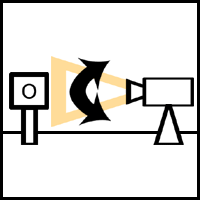
Tilting is a cinematographic technique in which the camera stays in a fixed position but rotates up/down in a vertical plane. Tilting the camera results in a motion similar to someone raising or lowering their head to look up or down. It is distinguished from panning in which the camera is horizontally pivoted left or right. Pan and tilt can be used simultaneously. In some situations the lens itself may be tilted with respect to the fixed camera body in order to generate greater depth of focus.
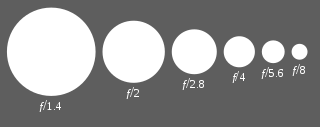
Deep focus is a photographic and cinematographic technique using a large depth of field. Depth of field is the front-to-back range of focus in an image, or how much of it appears sharp and clear. In deep focus, the foreground, middle ground, and background are all in focus.

A two shot is a type of shot in which the frame encompasses two people. The subjects do not have to be next to each other, and there are many common two shots which have one subject in the foreground and the other subject in the background.
This article contains a list of cinematic techniques that are divided into categories and briefly described.
Camera coverage, or coverage, is the amount and kind of footage shot used to capture a scene in filmmaking and video production. The film editor uses coverage in post-production to assemble the final cut.
The camera angle marks the specific location at which the movie camera or video camera is placed to take a shot. A scene may be shot from several camera angles simultaneously. This will give a different experience and sometimes emotion. The different camera angles will have different effects on the viewer and how they perceive the scene that is shot. There are a few different routes that a camera operator could take to achieve this effect.
Articles related to the field of motion pictures include:
In photography and cinematography, headroom or head room is a concept of aesthetic composition that addresses the relative vertical position of the subject within the frame of the image. Headroom refers specifically to the distance between the top of the subject's head and the top of the frame, but the term is sometimes used instead of lead room, nose room or 'looking room' to include the sense of space on both sides of the image. The amount of headroom that is considered aesthetically pleasing is a dynamic quantity; it changes relative to how much of the frame is filled by the subject. Rather than pointing and shooting, one must compose the image to be pleasing. Too much room between a subject's head and the top of frame results in dead space.
In filmmaking and television production, zooming is the technique of changing the focal length of a zoom lens during a shot – this technique is also called a zoom. The technique allows a change from close-up to wide shot during a shot, giving a cinematographic degree of freedom. But unlike changes in camera position, zooming does not change the perspective ; it only magnifies or reduces the size of the entire image as a whole.
This glossary of motion picture terms is a list of definitions of terms and concepts related to motion pictures, filmmaking, cinematography, and the film industry in general.


